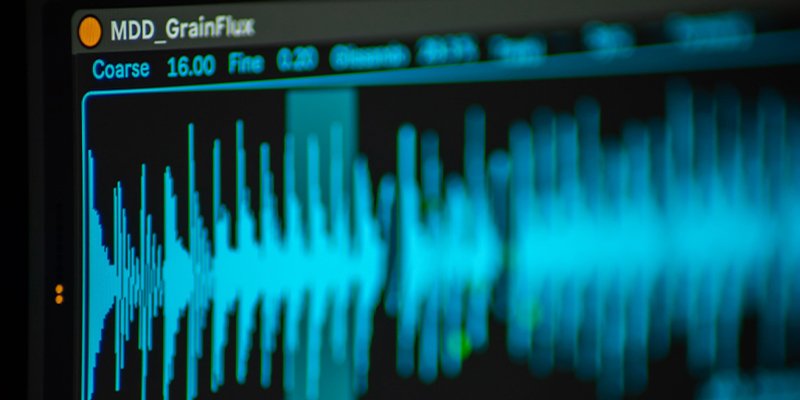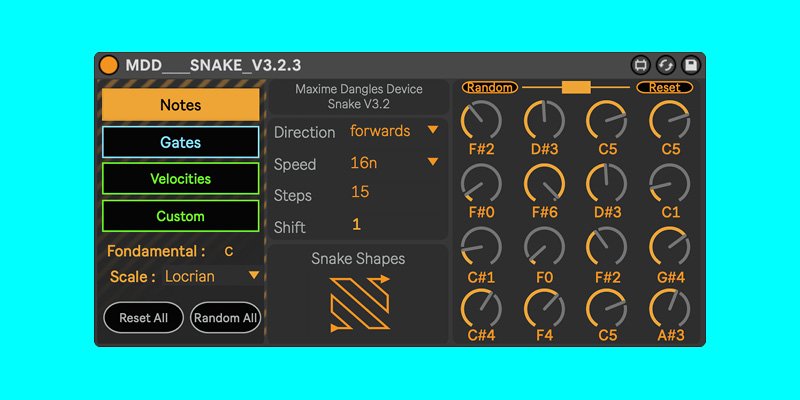Maxime Dangles: Unlikely Connections

Whether it’s collaborating with scientists on research into the impact of sound on marine ecosystems, or building and sharing his own devices for multi-channel live performances, Maxime Dangles experiences the world as one of endless and fascinating sonic interactions.
In the Ableton community, Dangles is recognized for his versatile sound design, wide-ranging productions and not least for his Max for Live sequencers. Behind minimalist and user-friendly faceplates of his characteristic orange, blue and green, his devices are built to bring complexity within reach for any music maker.
That ease of access is important to Dangles: for him, “the power of a device lies in its simplicity, and its ability to generate interesting ideas quickly.” With a smattering of randomization, his nimble tools work even basic ideas into unpredictable and evolving musical expressions.
Of course, they offer plenty of possibilities when it’s time to control the chaos, too: you can place notes, dial back the randomization and tighten gate lengths to plug the gaps in your groove with precision. Dangles says he finds a place for both random and controlled music-making in his own creative practice, depending on the day.
Catching up with Dangles over Zoom, we were curious to learn how he derives inspiration from creative roadblocks, and how an artistic residency in extraordinary surroundings shaped his new bundle of Multichannel Tools. Dangles gladly shared his own shortcuts to effective patches too, plus recommendations for beginners who want to go further with Max for Live.
We started with MDD SnAkE, the shape-shifting sequencer he modeled on Make Noise’s René. It’s a great showcase for his approach, and among the most popular devices ever shared.
“I think it’s popular firstly because it’s free,” he jokes, with a humility grounded in a deep appreciation for the craft of fellow creators. In the course of our chat, he gives a nod to Dillon Bastan, Monome, and the Make Noise team, and says he always checks the Max for Live website to see what others in the community are making.
But, he concedes, “It [SnAkE] is easy to understand too, and above all pretty fun. Even now, I often come back to it when I’m starting a track.”
If MDD SnAkE takes your fancy, it’s also worth checking out some of Dangles’s other free sequencers:
MDD Marionnette: a 16-step sequencer inspired by the MIDI possibilities of Monome’s Eurorack module, White Whale
MDD ARPOoO 2: a flexible arpeggiator modeled on the defining features of Roland’s Jupiter 6 and SH-101
Joining the dots
Dangles got interested in Max/MSP around the same time he was learning about modular synthesis. As the basics of inputs, outputs and signal flow became clearer, so did the commonalities between Max/MSP and the hardware gear Dangles was experimenting with.
“I bought the Monome ten-or-so years ago, and I remember opening up some of the patches and just being in awe of the complexity of it all. But, being a curious sort of person, I wanted to understand what was doing what, how it fit together.”
One day, during a long train journey, Dangles decided to watch a few Max/MSP tutorials. Happily, it wasn’t as impenetrable as first thought. Dangles’s friend had recommended copy-pasting elements from other devices he liked, so after he’d gathered bits of preexisting patches and explored the help pages, his first creative collages began to emerge.
Make a start
Dangles still keeps a central patch with all of his favorite elements, and describes the learning curve with Max for Live as exponential: once you’ve made one sequencer or synthesizer, you can repurpose chunks of your old patches and quickly make many more.
It’s an approach he recommends to anyone interested in getting going with Max for Live: “Looking under the hood of other devices allowed me to start to grasp what was going on, but also to come out with something functional at the end… Some of the free Packs included with Live are nicely laid out when you open the patches up. Building Tools is definitely a helpful example to copy from.”
Dangles has found that the Max community is always on hand to help with any problems, too – and he says the creative exchange in forums and on the Max for Live website is refreshingly good-spirited.
Patching the personal
It’s clear just how much room for self-expression Dangles finds in Max for Live. While the devices he shares are carefully color-coded and designed for the first-time user, he admits that they only ever stem from a need or challenge of his own, and that the first versions of his patches are a mess only he could navigate.

With a simple layout and clear color coding, MDD SnAkE is designed to be accessible even for those who have never used a sequencer before
In fact, he says, there’s something idiosyncratic in approaches to Max for Live more generally. “When you look at a patch a friend has made, even if you have a good understanding of the tools, you won’t necessarily see why they’ve connected this one to that one, or gone about things in that particular way… Today, I think if I looked at the Monome patches that first got me interested in all of this, I’d certainly be less scared – but I wouldn’t necessarily understand them.”
New surroundings
A change of scene often presents new creative opportunities. Just as the initial connections formed in Dangles’s mind during a train ride, the seed of his latest project, MDD Multichannel Tools, was sown during an artistic residency at the SAT in Montreal. Scoring the immersive film Ecosystem, he worked with underwater recordings of marine life, boats and the sea itself to immerse his audience in the complex questions of climate crisis.
SAT’s Satosphere is an impressive dome with 157 speakers, 8 projectors casting 360-degree visuals, and capacity for up to 150 people. “When I started to play around with spatialization there, I quickly realized that I didn’t want to place my sounds in any precise or logical way, I just wanted to mess around with the concept of the space as a whole.” Maxime says "I found the effect incredibly cool, the brain just doesn’t know how to handle it.”
Spatialization may have been a new area of exploration for Dangles, but in his Multichannel devices, much like his sequencers, he found a freedom in renouncing creative control. And for all the painstaking care and hours spent building them, these tools are remarkable for their immediacy: “I wanted to be able to take things I’d made at home on my stereo setup and, with just a couple of clicks, scatter them across a multi-channel sound system.”
Among the many creative devices included in MDD Multichannel Tools are:
MDD Grain Reverb and MDD Multi Comb Filter to Reverb: two highly experimental spatial reverbs
MDD GrainFlux: a granular synth in which each grain can be routed to a different speaker
MDD Supergrains SPAT: a synth with an integrated sequencer sending each step to a different speaker
You can download the pack of Max for Live devices and make a voluntary contribution on Maxime Dangles’s Gumroad.
The consistency of Dangles’ early releases on Kompakt and its sub-label Speicher left no hint as to the winding path of collaborations, live performances and experimental patching that would follow – and it’s equally hard to say what he’ll share next. Whatever his curiosity finds compelling, no doubt.
It’s a motif that comes through loud and clear in conversations with Dangles: his tendency to move towards what puzzles him. An openness to things he hasn’t tried, to new ways of expressing this outward-facing fascination. It’s somewhat infectious, and makes a great case for anyone daunted by Max for Live to simply get started with it. A prompt, too, to offer more space in our creative processes to the unknown and the accidental, and less to certainty.
Keep up with Maxime Dangles on YouTube, Instagram and SoundCloud
Text and interview by Henry Hodson